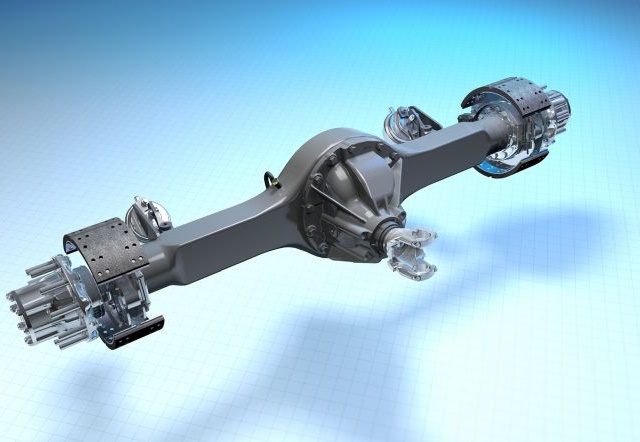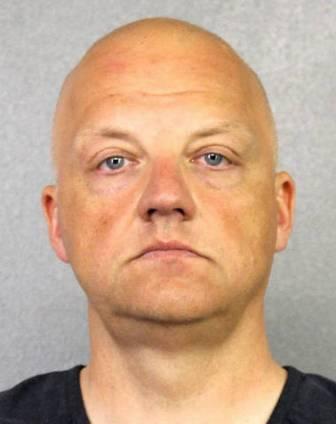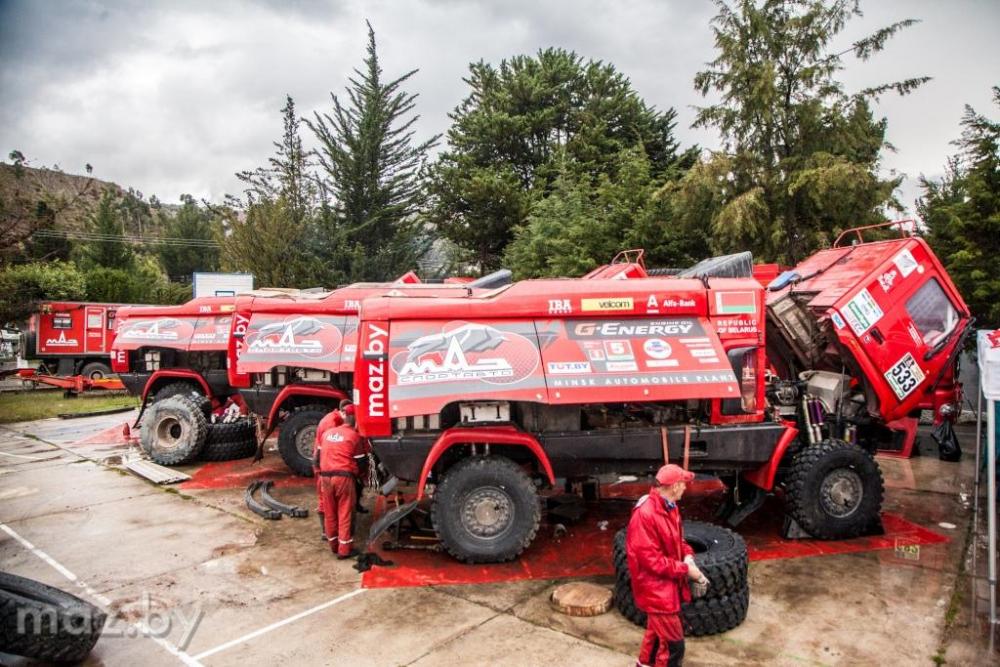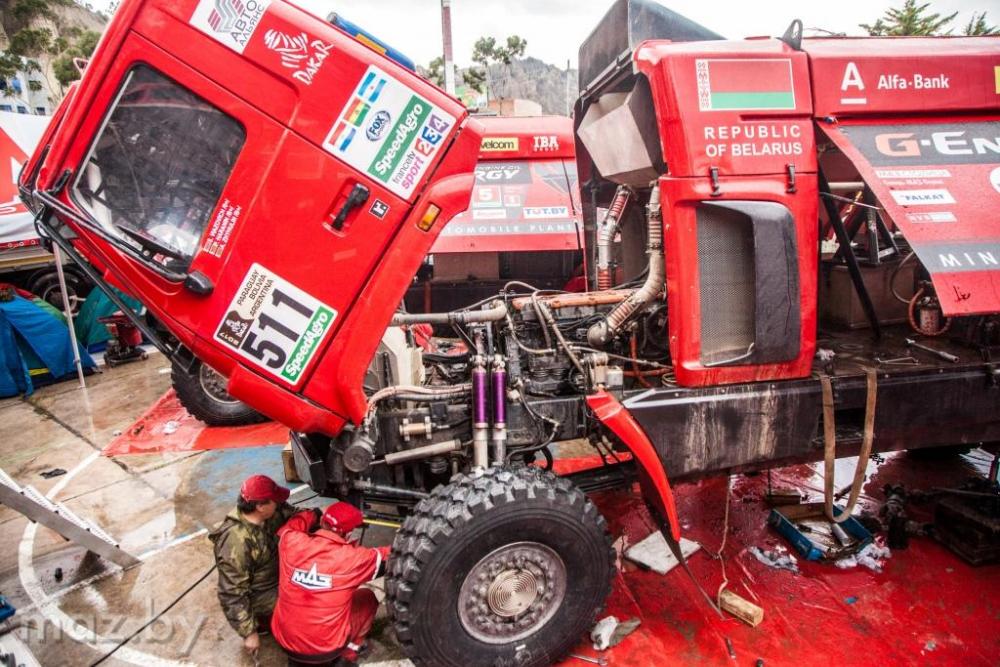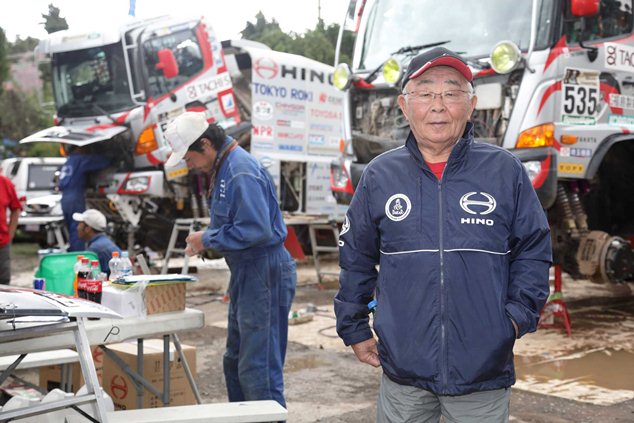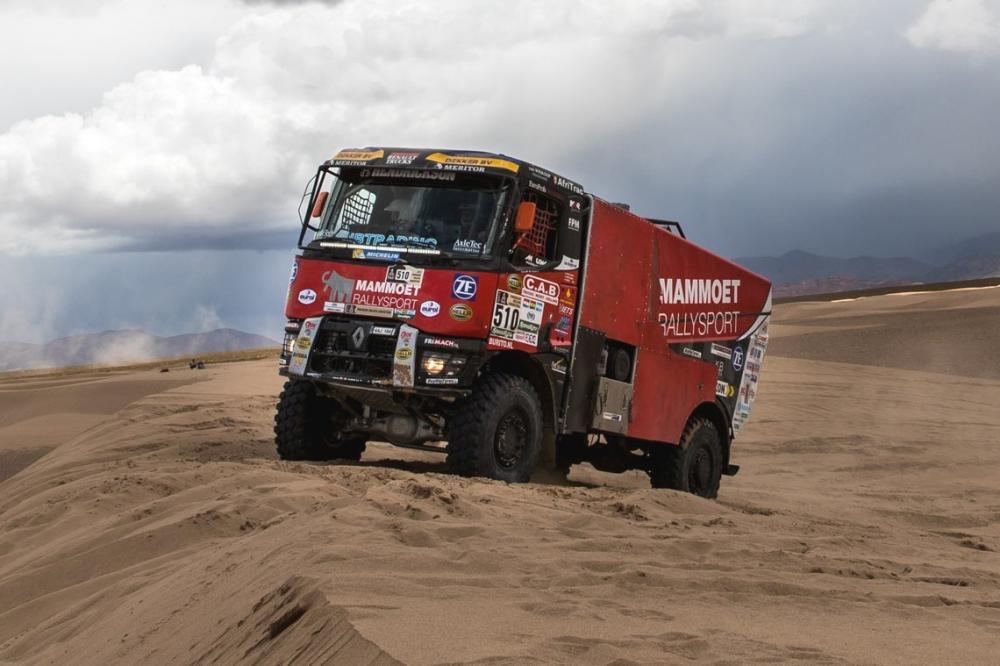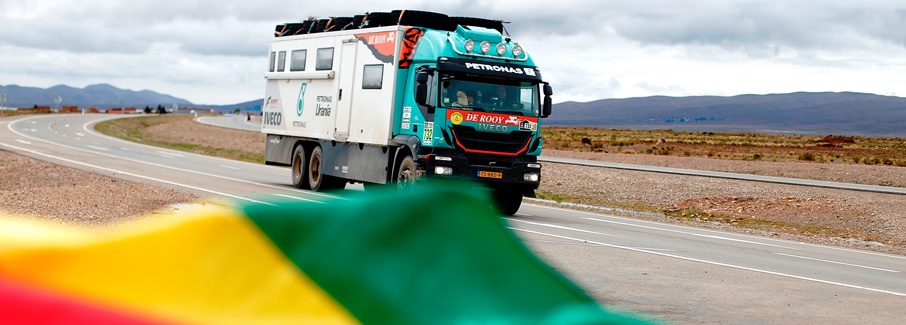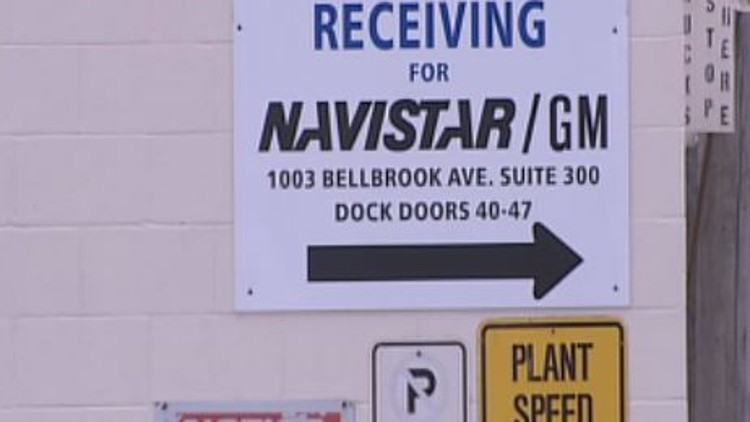
kscarbel2
Moderator-
Posts
18,895 -
Joined
-
Days Won
114
Content Type
Profiles
Forums
Gallery
Events
Blogs
BMT Wiki
Collections
Store
Everything posted by kscarbel2
-
Dakar 2017: IVECO wins two podium places and overall lead Iveco Trucks Press Release / January 10, 2017 The 2017 Dakar Rally caravan is again moving after two days without race activity due to heavy rain in Bolivia. The organisation was forced once again to shorten Stage 7, as a result of the continuous bad weather affecting the roads. The 322 kilometres special was cut to half and only 161 kilometres were taken into account for the clock in a mixed stage with sections of Stage 6 – which was cancelled on Saturday – and Stage 7. This is the beginning of the "Marathon Stage", where the teams of all categories except Trucks are not allowed to work on their cars and only the drivers are allowed to do the job. Despite of the difficulties for the participants, it has been a great day for the PETRONAS De Rooy IVECO Team. With the #507 Trakker, Ton van Genugten finished in the second place, only 2m51s behind Sotnikov, winner of the day. The Dutchman benefits from this fantastic result to advance in the overall classification, after a hard end of the first part of the Dakar. Gerard de Rooy, last Dakar winner in Trucks, secured a good fourth place that keeps him in the overall lead in his #500 Powerstar with five stages still to run until the arrival in Buenos Aires. Wuf van Ginkel, with the #525 Iveco Trakker, fell back to 13th place, 12 minutes behind the leader. This puts him more than seven hours behind the leaders and outside the Top 20 in the overall classification. In the #502 Powerstar, Federico Villagra achieved another podium finish and arrived third in Uyuni, less than one minute behind Ton van Genugten. The Argentine driver is now in fifth position, placing a second IVECO inside the Top 5 in the overall classification. The race will continue on its way to Argentina tomorrow, in a very long day for the participants. Almost 900 kilometres will be run, with 492 of them in a timed stage between Bolivia and Argentina. Stage 7 Results – Dakar 2017 1. Dmitry Sotnikov (Kamaz) 1h41m35s 2. Ton van Genugten (IVECO) +2m51s 3. Federico Villagra (IVECO) +3m37s 4. Gerard de Rooy (IVECO) +4m25s 5. Siarhei Viazovich (Maz) +5m22s ----------- 13. Wuf van Ginkel (IVECO) +12m19s Overall Classification – Dakar 2017 1. Gerard de Rooy (IVECO) 15h52m07s 2. Dmitry Sotnikov (Kamaz) +2m11s 3. Eduard Nikolaev (Kamaz) +5m57s 4. Airat Mardeev (Kamaz) +20m12s 5. Federico Villagra (IVECO) +33m42s ----------- 20. Ton van Genugten (IVECO) +6h05m29s 22. Wuf van Ginkel (IVECO) +7h12m28s .
-
Titan to be Discontinued
kscarbel2 replied to Mackpro's topic in Modern Mack Truck General Discussion
The Mack dealer body has been demoralized by Volvo for some time now, due to explainable sales marketing decisions including available product, and losing deals by $10,000 to $15,000. On one hand, they now feel naked without a large engine offering when the competition can all take orders for 15L and 16L engines. On the other hand, Volvo has never made the D16 available in any variant of the Pinnacle (e.g. Rawhide Edition), or Granite. So in fact, the Mack brand hasn't been able to compete on equal terms for some time. Unlike the Granite Series, one can order a Freightliner 122SD with either the DD15, DD16 or X15 (ISX15). I liken the Granite to the 122SD more than the Titan. Similarly, unlike the Pinnacle Series, one can order a Freightliner "New Cascadia" with either the DD15, DD16 or X15 (ISX15). Going up against the competition, the Mack brand dealer is empty handed. And yes, this IS one reason why Daimler has the largest Class 8 market share in the US market and Canada. Yes, the D11 (MP7) and D13 (MP8) can satisfy the needs of most customers*, providing a cheaper, lighter and more fuel-efficient alternative. But what about the customer's engine preference? This is European Volvo thinking, in that they want to tell you what engine you need, rather than listen to what engine the customer is saying they want. In the global market, Volvo dictates to the customer (and dealer body). But that business attitude doesn't fly in the US market. * Engine braking performance (Jacobs) is of course relative to displacement. -
The B was a better engine than the first which was a problem, but the C was same as the C12 block. The early 3176 was built where the crankcase was cast iron and there was a aluminum block bolted on top of the crank case and it was what held the liner and pistons. It was a source of oil and coolant leaks. And when you replaced the liner you had to pull the aluminum spacer of to replace the gaskets. It took too much time to over haul.The c came with the one piece block and crankcase like a real engine and better electronics. But still 10 liter engine. The problem with the engine was it was a oil leaker in the front around the front cover and most had the air compressor shaking lose. The good part was it was a light weight and could have good power. The C12 took its place and was a almost 12 liter engine. The first engine had a ECM on it like a 3046 PEEC. It had some sensors in the wrong places. You could not get to the boost sensor witch was stuck in the ECM and it was down low with a hose running from the air intake to it and water would from in it and steel in the sensor which was lower. This would stick the sensor and in most case in the low boost mode cause no power.Later engine was changed some. Being this is a 94 year it will have the later model engine but still is not a C12. Glenn Akers
-
Dayton Daily News / January 10, 2017 Shares of Navistar have rebounded sharply over the past year as analysts said the company’s finances have stabilized and the truckmaker got a major boost from a new partnership with Volkswagen. The company’s shares fell to a low of $5.78 in mid-January last year. But the shares have steadily risen and reached as high as $33.46 per share earlier this month — a nearly 400 percent increase. The improving share prices are beneficial for the company’s investors, many of whom are workers and retirees living in Clark County. The company’s Springfield plant is a major employer with more than 1,500 employees. The company has also worked to boost hiring in preparation for two joint agreements with GM. “We have a strong retiree base here and they want to see the company succeed as well,” said Mike McDorman, president of the Chamber of Greater Springfield. “We have a lot of new employees being onboarded there every day.” Analysts didn’t comment on the company’s share price specifically, but said it’s clear the manufacturer has undergone a turnaround and regained the confidence of investors and customers. Navistar also made significant news in September, when it announced an alliance with Volkswagen that calls for the German firm to buy a roughly 17-percent equity stake in Navistar and invest about $256 million. Vicki Bryan, a senior high yield analyst at Gimme Credit, said Navistar’s management should be credited with turning around a company that had been in serious financial trouble. Just a few years ago workers weathered turmoil that included top management changes, legal struggles, a recession and a failed engine technology. “They’ve built a durable model that can survive even in difficult market conditions and that’s appealing to Volkswagen because Volkswagen is looking to use this as its cornerstone North American presence,” Bryan said. Navistar officials also pointed to Navistar’s alliance with Volkswagen as a key to the company’s future. “While we won’t speculate on what drives stock performance, we will point out the majority of the increase came after we announced our proposed alliance with Volkswagen Truck and Bus in early September,” said Lyndi McMillan, a Navistar spokeswoman. “We are very excited about this alliance opportunity and the many benefits it offers the company.” McMillan also pointed out the company has taken major strides to improve the business. “The announcement has sparked improved consideration in the company with many stakeholders, including investors,” she said of the Volkswagen deal. “We’ll also point out we’ve seen four consecutive years of improved bottom-line performance, including in 2016 when the industry faced more challenging conditions. This company has achieved 10 years of progress in the last three plus years. We continue to demonstrate our resilience and the long-term viability of our enterprise.” The Springfield plant also is gearing up to begin production of a cutaway model of GM’s G Van beginning early this year. Navistar and GM also made a joint agreement in 2015 to build medium-duty trucks in Springfield. Those deals provided security, along will millions in new investments in a plant that as recently as 2010 had as few as 300 workers. Local leaders have credited better relations between the UAW Local 402 and the company’s management for making those deals possible. As Navistar underwent its recovery, Bryan said many analysts believed the manufacturer might run out of time to turn around as many companies were replacing aging truck fleets. That may have caused stocks to slide, despite Navistar’s improving financial position, she said. “Navistar is in better shape financially but it was not fully recovered,” Bryan said. Company officials recently said the trend of weak demand in the U.S. and Canada for heavy-duty trucks is likely to continue into at least the first half of next year. Navistar reported a net loss of $97 million in 2016 as the heavy truck market remained weak. But that’s half of what it lost the year before. Bryan said decisions Navistar has made in recent years puts the truckmaker in a much better position to thrive moving forward. “That doesn’t mean it’s not going to have some weaker quarters than others,” Bryan said. “But it’s not going to go bankrupt. It can cover its cost and it can cover its debt and retain a viable business model, even if market conditions are difficult. That’s an attraction for Volkswagen.” By the numbers 1,500: Current employees at Springfield Navistar plant 600: New jobs coming to Springfield plant as part of two deals with GM 400 percent: Approximate increase in Navistar’s stock price since last year $256 million: Investment from Volkswagen as it buys a stack in Navistar
-
Navistar, Dana Agree to Multi-Year Sales Agreement Heavy Duty Trucking / January 10, 2017 Navistar and component manufacturer Dana have inked multi-year deal for driveline components for on-highway, delivery, bus, and vocational vehicles. Dana will remain the standard-position driveshaft supplier across all Navistar truck models, and Navistar will have access to all of Dana’s current driveline product offerings.. The deal will also serve as a platform for collaboration on technologies under development. Dana's technologies for engine downspeeding are also available on a select offering of linehaul trucks from Navistar. The company's driveline package for downsped engines includes the Spicer AdvanTek 40 tandem axle and SPL 350 driveshaft. In addition, Navistar and Dana concurrently launched several extended warranty packages for Navistar's Durastar medium-duty truck program and its school bus platform. Spicer S140 Series and Spicer 060 Series axles, Spicer E-Series steer axles, and Spicer driveshafts are all available components covered under the International Durastar Powertrain Warranty program. Dana is also offering additional extended warranties on medium-duty truck and bus applications through the Dana Productivity and Dana Assurance packages. "The trucking industry is being driven by increasingly stringent efficiency standards, while vehicle owners and operators require steadfast reliability and low cost of ownership," said Tim Farney, vice president of global sales for Dana Commercial Vehicle Driveline Technologies. "Vehicle manufacturers and critical component suppliers must collaborate to deliver an optimized blend of performance and dependability for all trucking applications.” .
-
Transport Topics / January 10, 2017 Dana Inc. entered into a multiyear commercial sales agreement with Navistar International Corp. for driveline components for on-highway, city-delivery, bus and vocational vehicles. Dana announced the agreement Jan. 10 as the company also issued guidance for 2017. This arrangement also will serve as a platform for collaboration on new technologies under development, bringing the two companies together to cultivate solutions that meet the specific needs of Navistar's customers and increasing industry standards, the Maumee, Ohio-based supplier said. At the same time, Dana announced it will remain the standard-position driveshaft supplier across all models of Lisle, Illinois-based Navistar’s International Trucks. “The trucking industry is being driven by increasingly stringent efficiency standards, while vehicle owners and operators require steadfast reliability and low cost of ownership,” Tim Farney, vice president of global sales for Dana Commercial Vehicle Driveline Technologies, said in a statement. “Vehicle manufacturers and critical component suppliers must collaborate to deliver an optimized blend of performance and dependability for all trucking applications. With support from 16 technology centers located around the world, Dana has the unique ability to leverage global engineering knowledge, processes and technologies to serve any market," Farney said. Meanwhile, Dana's 2017-2019 sales backlog for all segments was $750 million as of Dec. 31 and benefited from new business, primarily in the light-vehicle driveline segment, according to the company. Increased sales from new business backlog are expected to add about $175 million to sales. In the medium- and heavy-truck sector, lower North American Class 8 truck production will be countered mostly by higher demand in other regions. Off-highway market demand levels are anticipated to be relatively comparable or modestly higher compared with 2016, the company reported.
-
Ford to Cancel Mexican Plant - Invest $700mm in Michigan Plant
kscarbel2 replied to General Ike's topic in Odds and Ends
Crain’s Detroit Business / January 10, 2017 Ford and Michigan officials are being tight-lipped about state economic incentives [free taxpayer money] the automaker will receive for the $700 million investment in its Flat Rock Assembly Plant for future production of electrified vehicles. Ford CEO Mark Fields Monday refused to reveal the incentives Gov. Rick Snyder's administration promised to secure the automaker's creation of 700 new jobs as part of an investment to bring up to 13 electrified vehicles to market. "We're in the process of working with the state and anticipating incentives to help support that investment," Fields told reporters during media day at the Detroit auto show. "We'll talk about that once the process is done." An incentives package will be presented at a later date to the Michigan Strategic Fund board for approval, said Steve Arwood, CEO of the Michigan Economic Development Corp. Arwood also refused to disclose what incentives Ford is getting for the Flat Rock investment plans, citing a nondisclosure agreement with the automaker. [Government cites a nondisclosure agreement with big business as an excuse for not telling Americans how their employees are spending taxpayer money] "We don't discuss those things publicly, obviously, until the Strategic Fund acts," said Arwood. Arwood said the incentive package will not involve adding to Ford's Michigan Economic Growth Authority tax credits, which were capped in June 2015 at $2.3 billion through 2031. Ford's agreement to cap the value of its MEGA tax credits was tied to $3.1 billion in capital investments and the retention of nearly 40,000 jobs in Michigan. The Snyder administration pushed Ford and crosstown rivals General Motors and Fiat Chrysler Automobiles to agree to caps on their MEGA tax credits in 2015 as part of an effort to rein in the ballooning cost of $9 billion in taxpayer subsidies promised to Michigan companies during the height of the economic recession. "We don't amend MEGAs," Arwood said. -
http://www.bigmacktrucks.com/topic/40960-volvo-group’s-mack-defense-unit-to-supply-1500-re-badged-renault-kerax-8x8-trucks-to-canadian-armed-forces/#comment-296894
-
David, I think we can all agree that we all "believe in America". For that specific reason, we have these deep and insightful discussions. Simply put, we care. We get many viewpoints in these discussions, which for me, broadens my horizons. But at the end of the day, we all passionately believe in America. For that reason, we are all troubled (to put it far too mildly) at the problems we see today. I myself enjoy a person who calls a spade a spade. Everyone here knows that. But Trump shouldn't use his time making fun of a handicapped person, or lambasting a celebrated actress. C'mon, be professional. We elected him to work on the real issues our country is facing, and that's a long list. Of course he doesn't enter office until the 20th, but one would assume he would/should be putting in long days this month ramping up to day one.
-
VW managers warned to stay in Germany as U.S. charges near Bloomberg / January 10, 2016 Some of Volkswagen Group's top executives may find it risky to leave Germany as U.S. prosecutors prepare to charge more company officials. Oliver Schmidt (pictured), a VW executive, was arrested in Miami as he was returning to Germany from vacation and faces charges of misleading regulators about the automaker's diesel-emissions cheating devices. U.S. prosecutors are preparing to charge more high-level German-based executives in the case. Schmidt's arrest caught many VW executives by surprise, including some attending this week's Detroit auto show. Lawyers for some senior VW executives in Germany have already warned their clients not to leave the country. Schmidt, 48, who was VW's liaison with U.S. environmental regulators, appeared in federal court in Miami Monday, where a judge ordered him held in custody as a flight risk. His lawyer sought Schmidt's release, saying his client had alerted the government he was visiting and was willing to speak with investigators and face charges. The court filing against Schmidt lays out what could be a road map to charges against higher-level executives. Volkswagen's senior officials in Wolfsburg, Germany, were told in July 2015 of the existence, purpose and characteristics of the device that lowered emissions on diesel cars when undergoing environmental testing, the U.S. alleged, citing information obtained from three cooperators. VW admitted its efforts to skirt environmental standards in September 2015. "VW employees assured VW executive management that U.S. regulators were not aware of the defeat device," according to the filing in federal court in Detroit. "Rather than advocate for disclosure of the defeat device to U.S. regulators, VW executive management authorized its continued concealment." VW has said top management was unaware of the decision to install the software to cheat emissions tests. "The then and current board of management of Volkswagen AG had, at any rate, no knowledge of the use of unlawful engine-management software at the time," Volkswagen wrote in its annual report for 2015. VW has suspended or pushed out about a dozen executives in the aftermath of the scandal including former CEO Martin Winterkorn, who has denied any knowledge of the cheating. The U.S. can charge individuals in Germany, but getting executives to stand trial in the U.S. could be difficult because Germany's constitution bars extradition of German nationals to foreign countries other than European Union members. Dozens of Volkswagen officials in Germany have hired U.S. criminal defense lawyers over the past several months as the Justice Department ramped up its investigation. U.S. authorities have traveled to Germany to arrange interviews with managers and seek cooperation. Schmidt began working for the automaker in 1997 and served as general manager in charge of its Environmental and Engineering Office from 2012 to 2015. That office was primarily responsible for communicating and coordinating with U.S. regulatory agencies. In March 2015, Schmidt was promoted to a more senior management position within Volkswagen and returned to the company's headquarters in Germany. After learning in April 2014 that West Virginia University's Center for Alternative Fuels, Engines and Emissions had found that three VW diesel vehicles had emitted 40 times the permissible limit in the U.S., Schmidt wrote to a colleague: "It should first be decided whether we are honest. If we are not honest, everything stays as it is.". In the same message, Schmidt noted that the International Council on Clean Transportation, an environmental group, had "stupidly" published the WVU findings. "Not good," he said. In the summer 2015, Schmidt took a direct role in VW's response to questions from U.S. regulators about the emissions tests. After these emissions-testing discrepancies became known to the U.S. government, he misled federal regulators about reasons for the differing test results. Schmidt offered "reasons for the discrepancy other than the fact that VW was intentionally cheating on U.S. emissions test in order to allow VW to continue to sell diesel vehicles in the United States." Schmidt is accused of participating in a conspiracy to defraud the U.S. government and Volkswagen customers and to violate the federal Clean Air Act from 2006 to 2015. The FBI affidavit lays out how in August 2015, senior Volkswagen managers approved a plan for what the automaker's employees would say in an upcoming meeting with California regulators. That plan called for Volkswagen employees to continue concealing the existence of the emissions device. However, one employee, who is cooperating with the investigation, ignored those instructions and admitted that Volkswagen cheated on U.S. emissions tests. The government notes in the criminal case against Schmidt that the charge against him is based in part on information from two cooperating witnesses who worked in Volkswagen's engine development department and also from James Liang, a former VW software engineer who pleaded guilty to a conspiracy charge in September. The unidentified witnesses are helping the U.S. in exchange for immunity from prosecution. The case is U.S. v. Oliver Schmidt, 16-mj-30588, U.S. District Court, Eastern District of Michigan (Detroit). .
-
REST DAY IN LA-PAZ MAZ Trucks Press Release / January 9, 2017 Rest day in Dakar can be called such only conditionally. Mechanics are working hard, preparing the trucks to the marathon stage to which the crew will go today. The stage 7 will go along the route La Paz - Uyuni. The bivouac will be organized only for sport trucks there. And only after the eighth stage the crews will meet with the rest of the team on the territory of Argentina already, in Salta. Tomorrow's special is reduced from 322km to 160. It is not surprising as heavy rains replaced long-term drought in Bolivia. Driving along mountain roads in such weather is very dangerous. Liason will be 644 km. Starting time of the crews at the stage 7: 511 (S.Viazovich / P.Haranin / A.Zhigulin) - 14:32:00 (21:32:00 Minsk time) 522 (A.Vasilevski / D.Vikhrenko / A.Zaparoschanka) - 14:34:00 (21:34:00 Minsk time) 533 (A.Vishneuski / M.Novikau / A.Neviarovich) - 14:38:00 (21:38:00Minsk time). .
-
Team Refreshes Their Trucks in Preparation for the Second Half of the Rally. Organizers Decide to Shorten the SS for Tomorrow, Jan. 9, Due to Bad Weather. On January 8 Rest Day La Paz (Bolivia) Jan. 8 was a day of rest for the teams in La Paz, Bolivia. Due to the cancelation of the stage leading to La Paz, the team arrived early and this has allowed them to begin inspections and servicing the day before. Servicing work centered on pre-scheduled replacements of parts. Although the mechanics had the intermittent drizzles to contend with, they were able to complete all necessary tasks, and by midnight, the team's two HINO500 Series trucks were fully refreshed and ready to race the second half. Meanwhile, organizers announced that they will be significantly shortening the SS for tomorrow, Jan. 9, due to the effects of rain near Uyuni. So far, HINO TEAM SUGAWARA's Car 2 crewed by Teruhito Sugawara and Hiroyuki Sugiura stands at 12th place in the overall trucks category, and Car 2 piloted by Yoshimasa Sugawara and Mitsugu Takahashi stands at 32nd place overall. Car 2 and Car 1 currently stand at first and second place, respectively, in the Under 10-litre Class. As impressive as these results are, the second half of the rally is expected to meet teams with a succession of challenging stages including a marathon stage on the first day where they will not be accompanied by their assistance squads, fesh-fesh and extreme heat near Fiambala, and dunes in the Andes foothills. The team's eyes are now on achieving their eighth consecutive class win as well as on how high in rankings Car 2 will be able to advance in the overall category. During a team meeting that was held after they completed their servicing work, members renewed their determination to work as a coherent team and give it the best effort that they have. Yoshimasa Sugawara: I received an IV transfusion last night at the medical center and I feel physically refreshed. I'm doing fine now. Mitsugu Takahashi: We would rather race the entire course under good weather, but there isn't much you can do with this kind of rain. And although the stage will be shorter, the dunes will probably make things quite challenging. Teruhito Sugawara: Racing the trucks category in the Dakar Rally has become quite the challenge in that you will fall back in standings unless you race at full potential in all of the stages. We will be facing a string of challenging stages in the second half so we intend to take it one day at a time. Hiroyuki Sugiura: Given these conditions, I was relieved to hear that the stage for tomorrow has been shortened. The total distance is longer though, so we may decide to avoid some areas. Seiichi Suzuki: On rest day, we replaced the rear leaf springs on Car 2, and focused inspections on vulnerable areas of the truck's drive train such as the transfer and reduction hubs. Car 1 has had relatively less fatigue so we carried inspections on the truck to the tee. Masaki Nakamura: The rain slowed us down, but I'm relieved that we were able to complete all of our work. One major work was the leaf spring replacement on Car 2, but we were able to complete that last night. Hiroyuki Azuma (Hino Motors Fukushima): I felt a bit tired on rest day because of the rain, cold, and a minor onset of altitude sickness, but I'm glad we were able to finish work on the trucks as planned. I'm feeling good physically. Koji Nakamura (Hino Motors Ishikawa): I haven't been able to adjust to the food, but I'm feeling pretty good physically otherwise. The rain can make something as simple as an oil change that much more difficult, so we took a lot of time today. Junya Inoue (Hino Motors Okayama): Once you start inspecting the truck, you start to notice one thing after another that might need to be looked into. There's never enough time. More so because we won't be around for the trucks tomorrow when they run the marathon stage. Kenji Kunimoto (Hino Motors Hiroshima): The rain was frustrating because it slowed our work down. The thin air in the highlands does give you a sense of actually being on the job. This rest day will be our last day of work in Bolivia so I am going to pull through with all I've got. Kohei Shimazaki: Things are going smoothly with transportation on our Hi-Lux. But we do have to fight drowsiness in the highlands. The toughest part so far has been the bivouac in Oruro where the ground had turned into a sea of mud. Koji Tanaka: It's obvious that the mechanics have been having a tough time since we arrived in Bolivia. Oftentimes, they can't even take a shower after work because of the cold. Ryu Takashima: My responsibility is to support the support group so I keep an eye out for what I can do to help. I've gotten used to how things proceed in the course of a day. I'm not sure if what I'm feeling is altitude sickness, but I am feeling the effects of low oxygen. .
-
Commercial Motor / January 9, 2017 .
-
. . . . . . .
-
. . . . . . . . . . . .
-
Renault Trucks Press Release / January 9, 2017 For the third time, the MKR Adventure team, led by Mario Kress, is tackling the extreme roads of the Dakar Rally behind the wheel of Renault trucks vehicles. After the first stages, the Renault Trucks K 520, driven by Pascal de Baar, occupies the fifth position in the overall ranking. After the sixth place clinched in 2016, MKR Adventure has once again risen to the challenge of taking part in the Dakar Rally, a competition that tests vehicles in extreme conditions. Three Renault Trucks vehicles have engaged in the race: a Renault Trucks Sherpa CBH 385 driven by Martin Van Den Brink (no. 506, Mammoet Rallysport team), a K 520 driven by Gert Huzink (no. 524, Riwald team) and a K 520 driven by Pascal de Baar (no. 510, Mammoet Rallysport team). After the first stages, the Renault Trucks K 520, driven by Pascal de Baar, occupies the fifth position in the overall ranking. As an MKR partner since 2010, Renault Trucks provides support for its off-road and rally raid activities; MKR Adventure are experts on extremely difficult terrain. During the Dakar, the vehicles are put to severe test, with sections of the race at an altitude of up to 4700 m above sea level. "At high altitude, our engine develops less torque and power. In thinner air, it is more difficult to rev up the engine," explained Mario Kress, describing the 336 km "special stage" on the border between Bolivia and Argentina. Through this partnership, the teams of Renault Trucks and MKR mutually enhance their technical and technological know-how, in particular of engines and the transmission system of trucks. .
-
Dakar 2017: IVECO in the lead as the crews take their rest day Iveco Trucks Press Release / January 9, 2017 The 2017 Dakar Rally arrived to the midpoint as the crews drove the connecting section to the camp in La Paz after Stage 6 was cancelled due to heavy rain and flooded roads. With five stages already contested, the IVECO Powerstar #500 driven by Gerard de Rooy, Moi Torrallardona and Darek Rodewald, is at the top of the standings. The PETRONAS De Rooy IVECO team leader won the last two specials after suffering three punctures in the third day of competition. Gerard de Rooy, with IVECO, leads in front of Eduard Nikolaev, Dmitry Sotnikov and Airat Mardeev with their Kamaz trucks, all of them locked within 16 minutes behind the leader. Dakar’s last champion did a solid job in South America’s hardest routes, in a competition that already crossed Paraguay, part of Bolivia and the north of Argentina. Ton van Genugten and Wuf van Ginkel will set their sights on returning to the Top 20 of the race in the second part, after losing more than four hours and an additional two-hour penalty in the last timed stage. Van Genugten, navigated by Anton van Limpt and Bernard der Kinderen in the Trakker #507, were stuck in mud, a nightmare for them and other drivers. Wuf van Ginkel, joined by Erik Kofman and Bert van Donkelaar in the Trakker #525, helped their teammates to get out from the difficult situation. This was a turning point for both crews, who were running inside the best 15 of the class. Now, they hope to have a clean second week. Federico Villagra, Adrián Yacopini and Ricardo Torlaschi, on board the IVECO #502, will aim to return to the Top 5, after falling back to sixth place in the first half of the race. With a good performance of the Powerstar and regular results, Villagra will try to repeat last year’s third place on the podium. The 2017 Dakar Rally will be travel south from this Monday onwards, when the vehicles leave La Paz to reach Uyuni after 322 timed kilometres. On Tuesday they will head back to Argentina to race in Salta, Chilecito, San Juan, Río Cuarto and Buenos Aires, going over the landmark of 2.000 kilometres in the last week of the race. Overall Classification – Dakar 2017 1. Gerard de Rooy (IVECO) 14h06m07s 2. Eduard Nikolaev (Kamaz) + 2m23s 3. Dmitry Sotnikov (Kamaz) + 6m36s 4. Airat Mardeev (Kamaz) + 16m32s 5. Pascal de Baar (Renault Trucks) + 32m25s ----------- 6. Federico Villagra (IVECO) + 34m30s 23. Ton van Genugten (IVECO) + 6h07m03s 25. Wuf van Ginkel (IVECO) + 7h04m34s .
-
Dayton Daily News / January 9, 2016 Navistar, a leading manufacturer of commercial trucks, is leasing warehouse space in Xenia, Ohio. Xenia is in southwestern Ohio, 21 miles southeast of Dayton. Details about Navistar's operations at the former Supervalu building on Bellbrook Avenue have not been disclosed. A sign on the building directs delivery drivers for the company to go to docks 40 to 47. Officials with the city of Xenia and Greene County confirmed that Navistar has applied for a certificate of occupancy. Some Xenia residents are excited at the possibility of new jobs being available. "Coming from a big city to a small town, it's encouraging to see Xenia being built up," said resident Leslie Robholz. We're working to find out more about Navistar's plans at the site. .
-
Freightliner Trucks Press Release / January 9, 2017 . . . . . . . .
-
Freightliner introduces next-generation Cascadia
kscarbel2 replied to kscarbel2's topic in Trucking News
-
Sorry then. When you mentioned a Chrysler transmission plant in Syracuse, I instinctively thought of New Process (It was renamed New Venture in 1990 when it became a Chrysler-GM joint venture).
-
https://www.cleanburn.com/ . .
BigMackTrucks.com
BigMackTrucks.com is a support forum for antique, classic and modern Mack Trucks! The forum is owned and maintained by Watt's Truck Center, Inc. an independent, full service Mack dealer. The forums are not affiliated with Mack Trucks, Inc.
Our Vendors and Advertisers
Thank you for your support!



